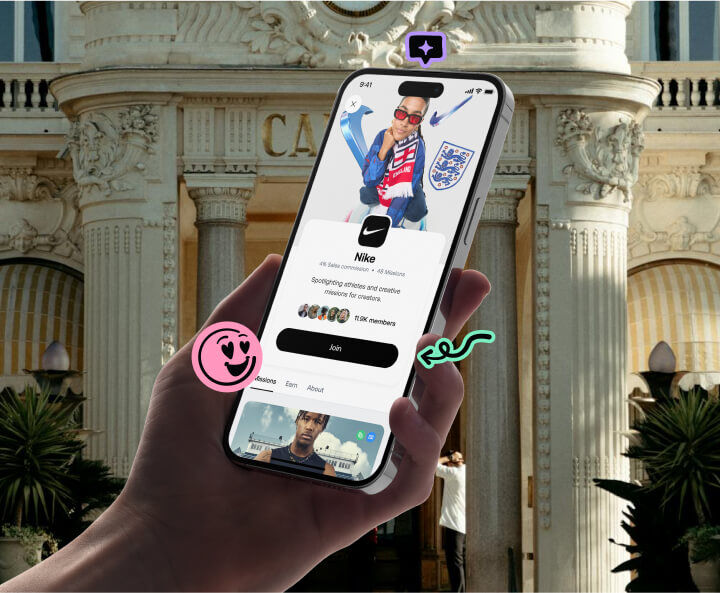7 best practices to avoid falling prey to brand ambassador scams
 7 best practices to avoid falling prey to brand ambassador scams">
7 best practices to avoid falling prey to brand ambassador scams">

Fake accounts, fraudulent offers, and convincing imitations of real brands have become alarmingly common. These scams have extended into brand ambassador marketing, where unsuspecting creators are approached to promote misleading or false claims.
Fraudsters are more sophisticated than ever, crafting deceptive websites and social media profiles that are nearly indistinguishable from legitimate ones. Their tactics aim to trick creators into handing over personal information or investing in bogus opportunities.

Brand ambassador scams prey on desperation
At their core, these scams exploit two powerful emotions: the excitement of being noticed by a brand and the desire to break into ambassador programs or influencer marketing. For many creators, especially those just starting out, the idea of partnering with a brand can feel like a big break. Scammers know this and use it to their advantage, presenting fake opportunities that seem too good to pass up.
Whether it’s promising exposure, commissions, or exclusive access, fraudsters rely on their victims' eagerness and lack of experience. They prey on the trust that comes with the perceived legitimacy of brand interactions, knowing many won’t question an offer that appears professional on the surface.
Activation campaigns are another key focus, turning loyal customers and engaged followers into ambassadors. Whether through reaching out to micro-influencers, launching seasonal challenges, or celebrating ambassadors’ achievements, these campaigns build a sense of connection and loyalty.
Without clear leadership, ambassador programs often lack direction, struggle with inconsistent campaigns, and fail to engage participants effectively. A strong manager ensures the program operates smoothly, the community stays unified, and the results reflect a solid return on investment (ROI).
To help you stay alert, we've highlighted six red flags to watch out for when approached by brands.

1. Is the account verified?
You receive an exciting message from what looks like your dream brand, inviting you to join their ambassador program. You click on the profile, and… no blue tick. That little verification badge might seem like a minor detail, but it’s your first line of defence against scams. Reputable brands wear it like a badge of honour to prove their authenticity. If you don’t see it, it’s worth pausing to dig deeper.

2. Double-check URLs for sneaky misspellings
Scammers are experts at creating URLs that closely mimic the legitimate ones. Always take a moment to carefully cross-check website links for even the smallest misspellings. For instance, instead of the well-known brand Nike, you might spot a subtle change such as “Nikee” with an extra “e.” These small tweaks can be hard to notice at first glance, but they make a world of difference.
It’s important to visit the brand’s verified social media pages to confirm their actual website link. Even one character off can lead you to a scam. Trust your instincts, if something doesn’t look or feel right, it’s worth investigating further. Scammers often rely on these tricks, so think of it as playing spot the difference - stay vigilant and ensure the link you’re clicking on is the real deal.

3. Poor grammar is a quick giveaway
If the account reaching out to you looks good at first glance, sharpen your eyes and put an editor’s hat on. Would a top-tier brand have messaging that reads like this: ‘’clik to join our ambassador programm”? Not likely.
Brands invest in their image and part of that is having solid copywriters and content editors who don’t allow bad grammar and ensure flawless communication. Scammers, on the other hand, tend to slip up—leaving behind clues like awkward phrasing, bad grammar, or clunky sentences.
Think of these signs as puzzle pieces. When put together, they paint a clear picture of what’s genuine and what’s not. Trust your instincts and look for professionalism—it’s what separates real brands from imposters.
4. Requests for personal details are a big red flag
Don’t run on excitement - pause and reflect. Why would a legitimate brand immediately request sensitive information such as bank details, a photo ID, or even private pictures? Scammers may request this information under the guise of “verification” or “partnership requirements” - stand firm and don’t fall for it.
Sharing personal data with scammers can lead to identity theft or financial fraud. For added security, consider using a VPN when communicating online. This simple tool adds an extra layer of protection for your data, ensuring your interactions are safer.
Stay alert, trust your instincts, and remember: a genuine opportunity doesn’t come with strings attached. Legitimate brands also don’t rush their processes nor threaten to use someone else because of time restraints.

5. Beware of pay-to-join offers
Here’s another common trap: a “brand” approaches you, offering an enticing ambassador opportunity. But there’s a catch—they ask you to buy their products upfront or cover “shipping costs” in exchange for exposure or commissions. This is a major red flag. As an ambassador, your efforts should be rewarded, not the other way around.
Fraudulent accounts often use vague, unprofessional methods to recruit, such as commenting “DM us to collab” on posts or including “DM to work with us” in their bios. Genuine brands don’t operate this way. They have structured recruitment processes, clear expectations, and upfront compensation models.
If you’re being asked to pay for the privilege of promoting a brand, it’s time to put on your shoes and walk away. Professional partnerships are built on mutual respect and transparency, not exploitation.
7. Liaise directly with the brand
If you’re ever unsure about an offer, the best course of action is to go straight to the source. Visit the brand’s verified website or reach out through their official social media profiles. Most legitimate brands have dedicated ambassador recruitment pages or clear contact information for inquiries.
When contacting the brand, ask specific questions about the offer you received. Genuine brands will gladly clarify whether the invitation is real. This step not only protects you but also helps the brand identify potential scams using their name.
If you’ve spotted suspicious behaviour, take action by reporting the fraudulent account to the brand’s customer service team or the social media network. Your vigilance doesn’t just safeguard you—it prevents others from becoming victims of the same scam.
Approaching brands directly is a simple yet powerful way to ensure you’re building authentic partnerships in a safe and professional way.

Club: Your partner in authentic ambassador marketing
At Club, we’re committed to connecting brands with passionate ambassadors who genuinely love their products. Our platform ensures security and authenticity, helping brands grow their communities without the risk of scams.
Ready to explore a smarter, safer way to collaborate with your favourite brands? Download Club today and start earning rewards when you complete Missions.
Keep up with the
latest from Club

Get more inspiration

7 best practices to build an effective brand ambassador program


Top trends brand ambassador programs will follow in 2025


 Book a demo
Book a demo



6. Analyse the brand’s social presence
A brand’s social media presence can tell you a lot about its legitimacy. Start by observing how the account looks and feels. Fake profiles often appear rushed or incomplete, with content that feels thrown together.
Look closely at their posts. Are all the posts uploaded within a short timeframe? This can indicate that the account is newly created, a common sign of a scam. Legitimate brands have a steady posting history that reflects their growth and consistency.
Next, assess the quality of the visuals. Low-resolution images, poor cropping, or generic designs that don’t match the brand’s identity are red flags. Genuine brands typically invest in professional visuals that align with their image.
Finally, pay attention to the comments. If many of them are repetitive or overly generic, like ‘Nice post!’ or ‘Great job!’ or come from the same accounts, it could be a sign of fake engagement. Scammers often use engagement pods or comment groups, where people are paid or instructed to comment on posts to make them seem more popular or credible.
This tactic can make an account appear active and legitimate, even when it’s not. Genuine brands foster meaningful, diverse interactions with their community
By taking these steps, you’ll have a clearer picture of whether you’re dealing with a trustworthy brand or a potential scam.